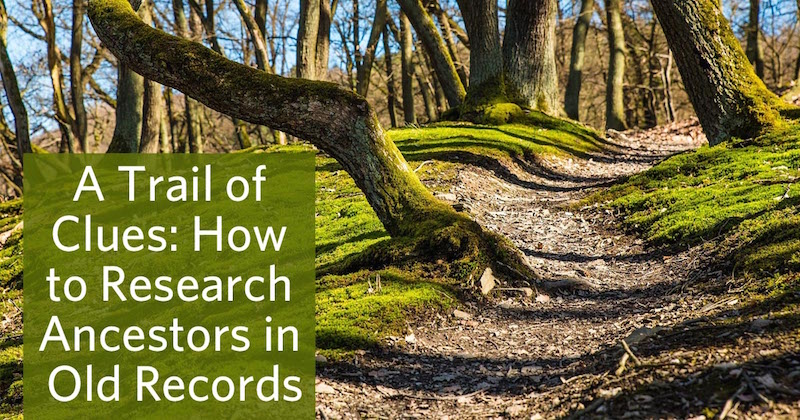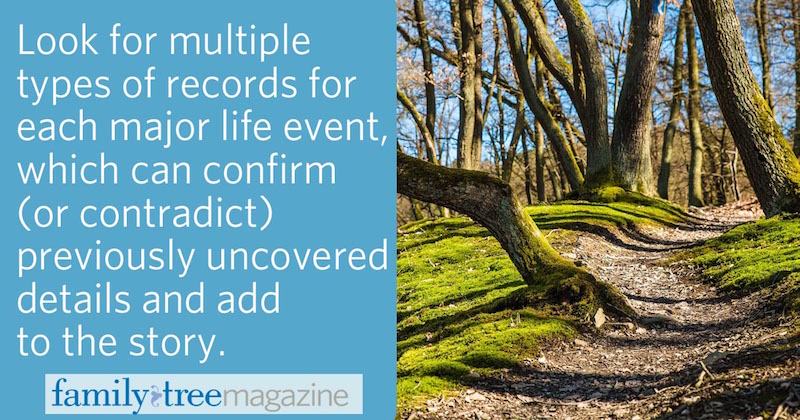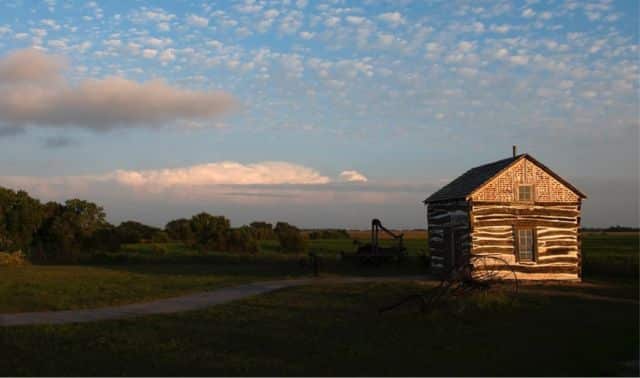
Each of our ancestors’ lives forged a similarly unique path through history. As a genealogist, you get to hike that path. The landscape is the time and place in which that person lived. Genealogical records serve as signposts, telling you where you are and pointing you in one direction or another.
Learning to discover and interpret the “trail markers” in genealogical records is a key skill for every family history hiker—and online tools and sites figure into this skill in a big way. So throw a laptop in your backpack and head for an ancestral trail you’ve been wanting to explore. These four principles—and genealogy website suggestions—will help you enjoy the adventure and arrive triumphantly at your destination.
1. Carefully read trail markers.
Directional arrows, labels and “You Are Here” maps keep hikers heading toward their destinations. Some signs also include icons or explanations that warn of danger, point toward additional attractions and share stories about the route. The careful hiker will stop, study the fine print and snap a shot for later reference.
Old records about your ancestors may include obvious directional arrows to guide you further into the past: a maiden name (launching your search for a woman’s parents), an overseas birthplace (sending you to church records in that town). But a record may have more to absorb than just these key facts. Pause to note every piece of information—and take a copy with you. Some of those seemingly minor details may take on new significance further down the trail.
When you find a new record (and if you haven’t done this for previously discovered documents), focus on extracting every clue. Transcribe it or create an abstract (summary) to help you digest all the details and create an easy-to-read “cheat sheet.” You won’t have to hunt for facts or decipher the handwriting each time you consult the record. Take a look at our case study Henry Fox’s records. Do you see how much easier it is to take in all the details at a glance from the transcription? Of course, keep a copy of the original document for when future questions bring you back to the source.
An online tree on a site such as Ancestry.com or MyHeritage, or genealogy software such as RootsMagic, has tools to makes this task simpler. Attaching a record from a website to one or more ancestors automatically pulls the site’s indexed information (and often, a citation) into your tree. Always check this information against the original record—mistranscriptions aren’t uncommon—and add transcriptions of the details that weren’t indexed. Make sure each record is associated with every person its names. For instance, a birth certificate that mentions a baby and two parents should be associated with all three people. Every member of a household, down to babies and resident mothers-in-law, should be tied to every census in which they appear.
If you upload a record from your computer to your tree or software, you can copy indexed information from the site where you found the record and paste it into your tree. If you can’t make out a word in the record, compare it to other documents in the database and ask for help from genealogy groups on social media. For foreign-language terms, use Google Translate and word lists on sites such as the FamilySearch Wiki.
Finally, file away each record image, source citation and piece of data on your computer in folders for each family or person named in the record.
2. Replace missing signposts.
Ideally, hiking trails have both the trailhead and the ending clearly identified, as well as mile markers to help you keep pace. Signs at the forks in the road point you in the right direction. If these clues are missing, you may wander off-course. The same thing can happen as you’re researching your family tree—but fortunately, you can pause and search for “replacement markers” before continuing your search.
The quality and availability of record substitutes varies by time, place and record type. First, seek out records created at the time of the event by eyewitnesses. Try to corroborate the details among multiple records from different sources. Look for records on genealogy websites such as Ancestry.com and FamilySearch. Search by place at the FamilySearch wiki, then read about available records in that location and search online to track down repositories or collections of interest. Follow up by calling or emailing records custodians with questions and ordering copies of records that aren’t online.
Birth records become rarer the further back in time you go. They’re critical, though, not only for marking a new life path but for identifying the intersection with the previous generation’s path. Newspaper birth announcements are largely a 20th-century tradition. Government birth records are less common before the late-19th to early-20th century. Before that, look to church baptismal registers or family Bibles. If you can’t find an official birth record, look for delayed birth records and other documents that pop up later in a person’s life and point to a birth date and place.
Certain life events may be marked by specialized records, such as a marriage certificate, an immigrant’s passenger list or an African-American freedman’s emancipation papers.
Watch for those predictable mile markers along ancestral paths, too:
- US censuses (every 10 years)
- state censuses, where available (often, every 10 years midway between US censuses)
- city directories (every year once publication began regularly)
- tax lists (annually, when in force)
- draft registrations for the Civil War or World Wars
Finally, the end of many trails is solidly marked with stone: a tombstone. But these may not exist for the poor, the enslaved, infants, travelers, those killed in combat (especially before the Civil War era) and others. Look also for cemetery records, obituaries, civil death records, coroner’s records, wills and probate records.
Sometimes the first record you find to document a life event won’t be the best one available. Follow its clues to see whether more reliable records lie around the bend. For example, when researching Henry Fox’s 1961 death, I learned that access to Colorado death certificates is restricted to certain close relatives. So I started with his tombstone image at Find A Grave. That identified his final resting place in Pueblo, Colo. Googling the cemetery led to its burial index, where Henry’s entry included the name George F. McCarthy. A staffer at the cemetery said this was the funeral home director and she gave me the number for the company, still in business. The funeral home sent me a copy of his entire file, which included the death certificate and an obituary.
The absence of an expected trail marker also can be a sign. If you don’t find evidence of a death or if a person isn’t where he should be in the census, he or she may have moved, enlisted, divorced, remarried or gone through some other life change. You might be unsure until you’ve traveled a little further down the road. So make note of missing records and keep an open mind—and a flexible course—until you’ve solved the mystery.
3. Take some side paths.
Some record signposts suggest scenic detours—additional record trails you could follow. Some of these may dwindle to dead ends, but others may take you to spectacular ancestral scenery. So study each record you find for pointers to promising routes off your beaten path. You can choose to follow them all or follow them selectively, such as when you’re desperate for a glimpse of insight into that person’s life. This table shows several such record routes you might explore.
| This information … | May lead you to … |
| address | deed, city directories |
| death date | obituary, tombstone, cemetery record |
| marital status |
marriage and divorce records |
| Social Security Number | Social Security application (Ss-5) |
|
birth date and place
|
birth and baptismal records |
| occupation | employment records |
| informant | person’s relationship to deceased |
| cause of death | description of condition |
| autopsy (if any) | coroner records |
| burial date and place | cemetery records, tombstone |
| funeral director | funeral home records |
I’ve followed up on some of these clues with mixed results—including one major success. I needed more documentation of Henry Fox’s parents’ names. I couldn’t find a Nicolic or Mary (Eirman) Fox—the parents’ names on his death certificate—in the Denver area at the time of Henry’s birth. But FamilySearch has an indexed Denver marriage record for a Mike Fox and Mary Eiarmann. Plugging Henry’s name and Social Security number (together and separately) into the Social Security Death Index (SSDI) database, free at several genealogy websites including FamilySearch and GenealogyBank), was unsuccessful. Same for Ancestry.com’s Social Security Applications and Claims index, a newer resource that adds millions of parents’ names and other information not in the SSDI. This isn’t unheard of, as the SSDI holds mostly deaths from 1962 (when the list was computerized) and later.
With Henry’s Social Security number, I forked over $27 to order a copy of his Social Security application form, or SS-5. Henry’s SS-5 confirmed that his father’s name was Mike, though his mother’s surname on that document is Armor (say “Armor” in a certain way and it sounds a lot like “Eairmann”).
Henry’s SS-5 also yielded a rare US Employment Service number. A little research and an email to the National Archives told me that at some point, he worked for the federal government and this generated a federal civilian file. I’m still following this trail, but so far it points toward government construction work for the Army/Air Force, possibly in Flagstaff, Ariz. How interesting!
Meanwhile, I’m taking one more side path in search of Henry’s probable parents in Denver. Their indexed marriage record, is like a faded roadside marker: it’s tough to read correctly and some information may be missing. I ordered a copy of the original, also shown. As you can see, it doesn’t tell me much more than the index does.
The certificate does spell out that the officiant was a Catholic priest in Denver, Colo. An 1889 Catholic directory at HathiTrust Digital Library helped me identify the priest’s home parish. I couldn’t find a phone number or website for the parish, so I called the Archives of the Archdiocese of Denver. The archivist had the sacramental records for that parish and sent me a copy. It includes the probable parents’ birthplaces and their parents’ names.
Unfortunately, the same parish didn’t have a baptismal record for young Henry, which would have definitively tied them together. But Henry’s obituary mentions funeral services at another parish, so he was Catholic, another clue that I may be on the right trail. Next, I’ll investigate the marriage witnesses in Denver and follow the bride’s parents back to Ohio. Either or both may confirm relationships and shed more light on the family’s story.
4. Keep your original destination in mind.
It could be tempting to take every little promising side loop off your main trail—and then perhaps forget where you were going in the first place. But for many who love hiking into the past, exploring those scenic detours and even thrashing around in the underbrush for missing trail markers is a welcome challenge. And the stories uncovered from, say, following a mysterious cause of death into newspapers and court records—or an SS-5 into federal employment during the Great Depression—may be worth every extra mile traveled to find them.
Tip: Look for multiple types of records for each major life event, which can confirm (or contradict) previously uncovered details and add more information to the story.

More Online
For Plus Members
Five steps to finding vital records
Getting the original record
Online translation tools
Family Tree Shop
Organize Your Genealogy book
Solutions for Missing Records video class
Birth Certificate Substitutes video class




